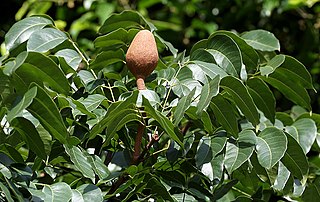Ironwood is a common name for many woods or plants that have a reputation for hardness, or specifically a wood density that is heavier than water, although usage of the name ironwood in English may or may not indicate a tree that yields such heavy wood.

The curry tree, Murraya koenigii or Bergera koenigii, is a tropical and sub-tropical tree in the family Rutaceae, native to Asia. The plant is also sometimes called sweet neem, though M. koenigii is in a different family to neem, Azadirachta indica, which is in the related family Meliaceae.

Zanthoxylum is a genus of about 250 species of deciduous and evergreen trees, shrubs and climbers in the family Rutaceae that are native to warm temperate and subtropical areas worldwide. It is the type genus of the tribe Zanthoxyleae in the subfamily Rutoideae. Several of the species have yellow heartwood, to which their generic name alludes. Several species are cultivated for their use as spices, notably including Sichuan pepper.

Chloroxylon is a genus of trees in the family Rutaceae. The genus comprises two species, both desired for their wood as high quality tropical timber and heavily exploited.

Chloroxylon swietenia, the Ceylon satinwood or East Indian satinwood, is a tropical hardwood, the sole species in the genus Chloroxylon. It is native to southern India, Sri Lanka, and Madagascar.

Swietenia is a genus of trees in the chinaberry family, Meliaceae. It occurs natively in the Neotropics, from southern Florida, the Caribbean, Mexico and Central America south to Bolivia. The genus is named for Dutch-Austrian physician Gerard van Swieten (1700-1772). The wood of Swietenia trees is known as mahogany.

Bloodwood is a common name for several unrelated trees, including:

The term Uzazi refers to the dried fruit of the West African deciduous shrub Zanthoxylum gilletii, syn. Fagara tessmannii, a member of the 'prickly ash' Zanthoxylum genus. The name of the spice is derived from Igbo, a language in Nigeria, where the spice is grown and harvested on a commercial basis. Zanthoxylum gilletii is a close relative of the Sichuan pepper, and uzazi has a similar taste profile to the Asian spice. However, unlike Sichuan pepper where only the pericarp of the fruit is used, uzazi is used whole. This may explain why uzazi has a spicier flavour and greater pungency than sichuan pepper.

Zanthoxylum flavum is a medium-sized tree in the family Rutaceae. Common names include noyer, West Indian satinwood, yellow sanders, tembetaria, and yellow sandalwood. It is native to Anguilla, Antigua and Barbuda, the Bahamas, Bermuda, Cuba, the Dominican Republic, Guadeloupe, Haiti, Jamaica, Puerto Rico, and the Florida Keys, exclusive of Key West where it has been extirpated. It is threatened by habitat loss and harvesting for its dense, durable wood used in fine woodworking.

Zanthoxylum brachyacanthum, known as thorny yellow-wood, satinwood, satin tree or scrub mulga, is a species of flowering plant in the family Rutaceae and is endemic to north-eastern Australia. It is a rainforest shrub or tree with thick, cone-shaped spines on the trunk and prickles on the branches, pinnate leaves, and male and female flowers arranged in panicles.
Indian mahogany is the common name for two species of trees in the family Meliaceae:
Flavum is a Latin word meaning "yellow". It is often used in taxonomy for species names typically in scientific names for animals and plants to refer to the flower colour or other aspect of the species.

Zanthoxylum nitidum, commonly known as shiny-leaf prickly-ash, tez-mui or liang mian zhen, is a species of flowering plant in the family Rutaceae. It is a woody climber with prickles on the branchlets, thick, cone-shaped spines on the trunk and older branches, pinnate leaves with five to nine leaflets, and panicles or racemes of white to pale yellow, male or female flowers in leaf axils and on the ends of branchlets.
Zanthoxylum gilletii, the East African satinwood, is a tree species in the genus Zanthoxylum found in Africa. The fruits are used to produce the spice uzazi.

Zanthoxylum rhetsa, commonly known as Indian prickly ash, is a species of flowering plant in the family Rutaceae and occurs from India east to the Philippines and south to northern Australia. It is a deciduous shrub or tree with cone-shaped spines on the stems, pinnate leaves with between nine and twenty-three leaflets, panicles of white or yellowish, male and female flowers, followed by spherical red, brown or black follicles.

Xylosandrus crassiusculus, known generally as the Asian ambrosia beetle or granulate ambrosia beetle, is a species of tropical bark beetle in the family Curculionidae. It is native to Asia and has spread to Africa, Europe, Australasia and the Americas. The adult beetle is reddish-brown and some 2 to 3 mm long.










